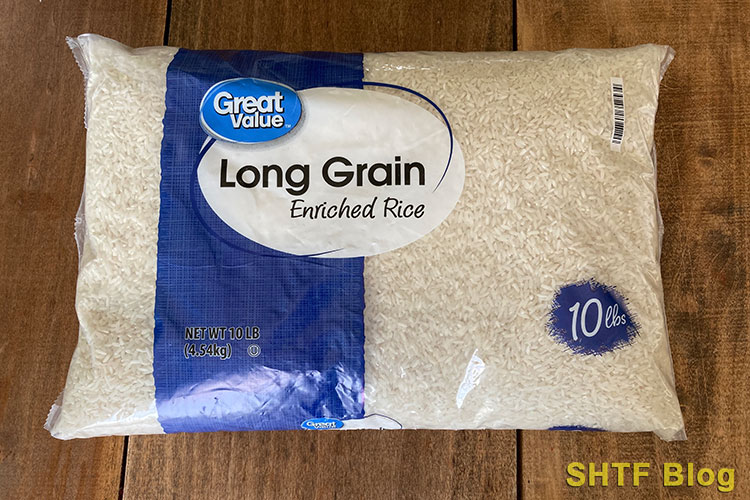
Storing food long-term is Prepping 101 and storing rice long-term is step one. Combined with bean storage, rice is a staple in the list of best foods for long-term storage.
When we make an action convenient – when we eliminate the barriers to a goal being accomplished – we make it that much more likely that the target will end up being met. Even if the barriers are largely imaginary – such as the idea that building up emergency food storage is expensive – eliminating barriers still matters.
This is why rice is a fantastic starting point for those who are new to prepping. Rice can be used to make a family more food-secure in as convenient a manner as possible.
Why Store Rice
If you’re looking for a long-term food storage item, you can’t go wrong with rice. Rice is cheap, readily available, nutritious, and can be stored for a very long time.
Just one cup of uncooked rice contains 716 calories. This means that you can easily store a calorie-dense meal for disaster purposes with minimal effort on your part. As of this writing, you can get a 10-pound bag of white rice from your local Walmart for roughly $4.60. You can buy a 15-pound bag of the popular Royal Basmati Rice on Amazon for under $30.
- AUTHENTIC FLAVOR: Long and fluffy, naturally aromatic, long grain Basmati rice; Aged for non-sticky texture and sweet flavor
- NATURALLY SOURCED: Sourced from local growers in Himalayan regions renowned for producing the finest crops
- VERSATILE WHITE RICE: Great long grain white rice for Indian food or Mexican food dishes; Add to curry, rice pilaf, stir fries, or enjoy as a side on its own
- NUTRITIOUS ROYAL RICE: Vegan, gluten-free, kosher, halal, non-fat, low sodium, and cholesterol-free
A ten-pound bag will give you 100 servings of rice at 160 calories/serving, meaning that 10 pounds of rice will contain 16,000 calories.
That’s a lot of calories for not much money. Prepping doesn’t have to be expensive, see?!
There are other reasons rice is great for long-term food storage:
- It’s a good source of complex carbohydrates,
- It has an ancient record as a staple food (and still is for many people), and
- It pairs well with other foods.
How Rice Was Stored Historically
You know something is good when it’s stood the test of time, and rice is no exception. It’s been eaten by mankind for millennium, and for good reason! Rice is filling, nutritious, and once more, stores very well! This means rice was a vital means to warding off starvation during times of drought or famine throughout history.
And it’s still an incredibly important food crop worldwide. Currently, it’s responsible for about a fifth of all calories consumed worldwide and is the staple food of more than 3 billion people worldwide.
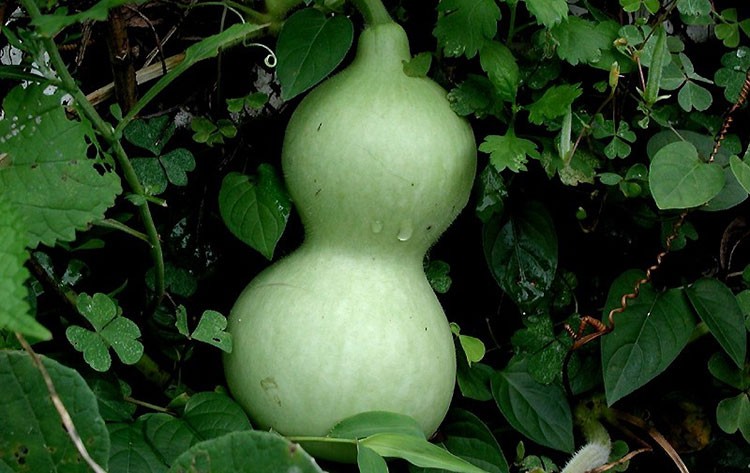
But just how did people in ancient history store rice? Rice, and other grains, were often “solarized” – laid out in the sun to first kill any insects. Then it was stored in earthenware jars or gourds and combined with diatomaceous earth (source). In this manner they could keep rats, bugs, and moisture out of their precious food so that it was safe to eat at a later date.
How Long Can You Store Rice?
The right rice stored in the right conditions can last for up to 30 years or more! The key is ensuring that your rice is properly protected from heat, moisture, and pests. If you can do that, you’re going to be good to go.
| Rice | Shelf Life when Sealed without Oxygen | Shelf Life in Store Packaging | Shelf Life when Frozen |
|---|---|---|---|
| White Rices (long-grain, jasmin, basmati, etc.) | 30+ years | 4-5 years | 30 years |
| Brown/Black/Purple | 18 months | 3-6 months | 12-18 months |
| Wild Rice | 30+ years | 10 years | 30 years |
White rice can store for roughly 4-5 years of its own accord. If you can keep your rice oxygen free, however, you’re looking at roughly 30 years that it can stay safe and good to eat.
White rice is by far the best type of rice to store. It is readily available, cheap, and lasts a very long time. Brown and other colored rices typically have their husks (hulls) still on. These husks have natural oils in them that oxidize and cause spoilage sooner than if the husk was not present. Refined white rice doesn’t have this problem, and thus, that’s what you want for strong rice long-term as a prepper.
Unfortunately, white rice is not as healthy as brown. The husk provides higher levels of fiber, magnesium, and other nutrients.
Wild rice looks really good in the chart above, but wild “rice” isn’t really a rice at all. It’s actually a semi-aquatic long-grain grass that grows in shallow waters of lakes, tidal rivers, and bays. The husk is hard and inedible. It’s also very difficult to harvest and process. The University of Minnesota has done extensive research on wild rice. It may have a long shelf life but given its difficult to process (and the fact it isn’t a rice), it’s not something most preppers will opt to store in large quantities.
Storage Containers for Rice
The best way to store your rice for daily use is to put it in some type of airtight container and away from light.
If you’re storing rice for the long haul, then you need containers that can effectively seal out pests and oxygen. If you’re not storing the rice in a dark place, then you also want a container that can block out light. The seal is the most important, however, because without it oxygen absorbers will not work. Air will penetrate the container.
The most common storage containers for rice include Mylar bags, Mason jars, #10 cans designed for food storage (enamel lining), and food grade buckets.
| Container | Pros | Cons |
|---|---|---|
| Mylar Bags | – Come in various sizes – Blocks light – Reasonably priced | – Must be vacuum sealed – Bags can be punctured – Not rodent proof |
| Mason Jars | – Good for meal-sized storage – Rodent proof | – Prone to breaking – Does not block light – Expensive for amount of food held |
| #10 Cans | – Rodent proof – Blocks light – Convenient sizing – Durable | – Not readily available – Requires sealing equipment – They can rust in humid environments |
| Food Grade Buckets | – Rodent proof – Blocks light – Durable – Inexpensive for the amount of food held | – Requires special sealing lids – Not a true moisture/oxygen barrier |
How Preppers Store Rice
You will find the vast majority of preppers storing white rice in Mylar bags set in food-grade buckets. That’s what I do. That’s what most people do. You get the vacuum seal effect with Oxygen absorbers sealed in Mylar bags and the rodent-proof, durability that buckets provide.
Preppers store rice for a long time by:
- buying white rice,
- putting it in Mylar bags,
- adding Oxygen absorbers,
- sealing the bag,
- putting the bag in a food grade bucket, and
- storing the bucket in a cool place a few inches off the floor to promote airflow.
Buy Your Supplies
Assuming you already have your rice, I would now go out and buy some 5-gallon buckets. While food grade buckets are the best, I’m not hesitant to use a Lowe’s bucket, particularly because I’ll be incorporating Mylar bags which will block contact between the rice and the bucket.
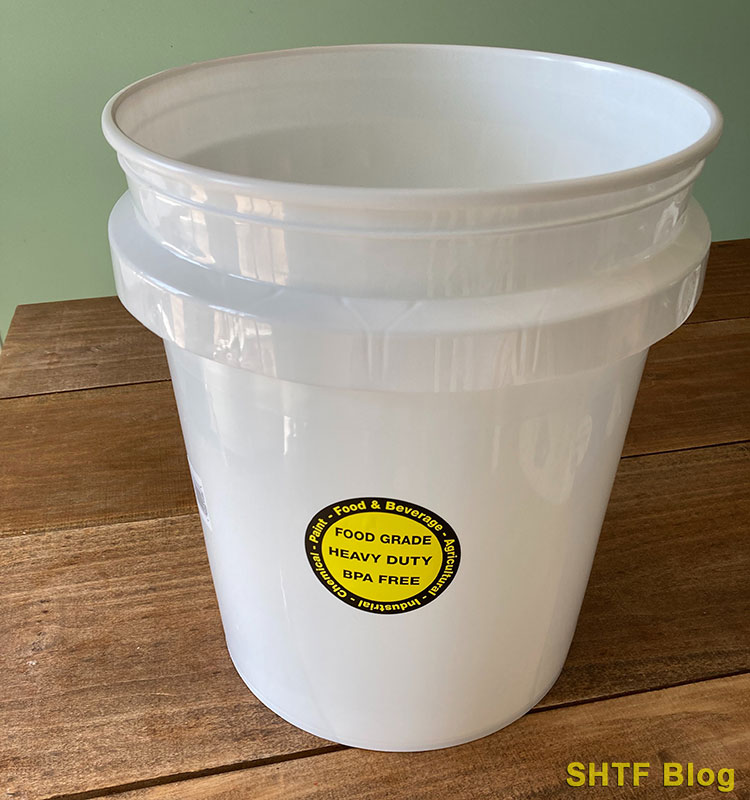
The next step would be to invest in some large Mylar bags. Unless you’re using a food-grade 5-gallon bucket, you don’t want your food coming into contact with the plastic.
- Heavy-Duty & Versatile Mylar Bags: Our 20"x30" mylar bags for food storage are 4.3 mil thick, offering exceptional durability and puncture resistance. Ideal for long-term food storage, these mylar...
- Reusable & Sealable: These 10 5-gallon mylar bags can be heat-sealed with a hot iron and resealed after opening. Each package includes oxygen absorbers (2000cc each) to maintain an airtight seal for...
- Ideal for Long-Term Food Storage: Perfect for preserving dried and dehydrated foods like grains, coffee beans, nuts, and more. These mylar bags with oxygen absorbers ensure your food remains fresh for...
- Comprehensive Protection with Oxygen Absorbers: Each bag comes with a 2000cc Oxy-Sorb oxygen absorber featuring an indicator pill to monitor oxygen levels, ensuring optimal conditions for long-term...
Chemicals can be absorbed by the rice and you can end up ingesting stuff you don’t want to/having some funky tasting and smelling rice. Rice is incredibly absorbent, so keep that in mind when you’re considering how you’re going to store it.
Now, you’re going to want some food-safe oxygen absorbers. These will eliminate the air in the bucket after you shut the lid from causing long-term damage to your rice storage.
Oxygen absorbers are typically sold in the following sizes (links carry you to Amazon listing).
The following table is a rough guide for how many oxygen absorbers to use. When in doubt, be liberal. You cannot use too many absorbers.
| Container | Dense Food (wheat, flour, grains) | Less Dense Food (pasta, beans) |
|---|---|---|
| Food Storage Buckets | Total CCs | Total CCs |
| 6-Gallon Food Bucket | 2000 | 2500-3000 |
| 5-Gallon Food Bucket | 2000 | 2500-3000 |
| Mylar Food Storage Bags | Total CCs | Total CCs |
| 20″ x 30″ (4.25, 5, and 6 gal) | 2000 | 2500-3000 |
| 18″ x 28″ (4.25, 5, and 6 gal) | 2000 | 2500-3000 |
| 14″ x 20″ (2 gal) | 1000 | 1500-2000 |
| 14″ x 18″ x 6″ (2 gal) | 1000 | 1500-2000 |
| 12″ x 18″ (1.5 gal) | 500-800 | 1000-1200 |
| 12″ x 16″ x 6″ (1.5 gal) | 500-800 | 1000-1200 |
| 10″ x 14″ (1 gal) | 300-400 | 400 |
| 10″ x 14″ x 4″ (1 gal) | 300-400 | 400 |
| 8″ x 12″ (1/2 gal) | 100-200 | 200-400 |
| 8″ x 12″ x 4″ (1/2 gal) | 100-200 | 200-400 |
| 6″ x 10″ (1/4 gal) | 100 | 100-200 |
| 6″ x 8″ x 2″ (1/4 gal) | 100 | 100-200 |
| Mason Jar Size | Total CCs | Total CCs |
| 1 Gallon | 400 | 400 |
| 1 Quart | 50 | 50 |
| 1 Pint | 50 | 50 |
| 1/2 Pint | 50 | 50 |
| 1/4 Pint | 50 | 50 |
Next, purchase gamma seal lids either from Lowe’s or from Amazon. They’re more expensive than standard lids, but for frequent access to the bucket, they’re well worth the extra money. Peeling off a 5-gallon bucket lid is a pain in the butt, and a gamma seal lid makes the process much more enjoyable. Plus, you’re not likely to eat 5-gallons worth of rice in one sitting. You’re going to take a scoop out and then shut your bucket back. A screw-on gamma seal lid makes this whole process convenient and easy.

In addition, a gamma seal lid better seals out moisture from damaging your rice as well. They cost about $10, as of this writing, but they are well worth the peace of mind that they’ll give you should disaster strike.
Put it All Together
Put your rice inside the Mylar bag. Throw in enough food-safe oxygen absorbers, dispersing them between the bottom, middle, and top of the bag.
Seal your Mylar bag with a clothes iron on the hottest setting. The following image, from my article on coffee storage, illustrates how a sealed bag should look after sealed and O2 absorbers are added.

Above, on the right, you see where the bag was sealed with an iron. One day later the oxygen absorbers have sucked what air remained in the bag. Follow the same process when storing rice long-term and you’re good for decades!
Now clamp down your gamma seal lid and screw it on tight.
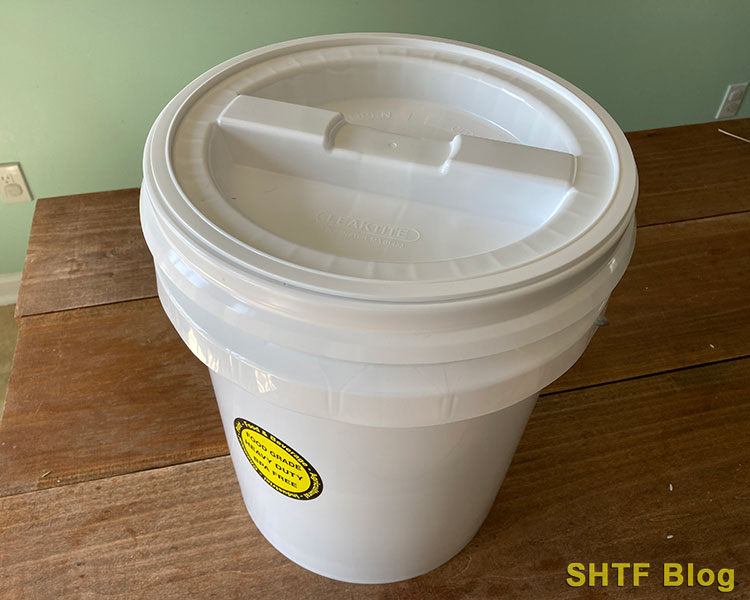
Voila! You’ve got a long-term solution for rice storage!
A Word About Bugs
Bugs are as big a problem as oxygen when storing rice long-term. Good news is that using oxygen absorbers will starve the bugs of the air needed to survive. If you are storing rice for shorter-term use and want to avoid sealing the rice to kill bugs, freeze the rice for a few days and then put it in an airtight, bug-proof container. The freezing process will kill the bugs and placing it in a tight container will keep new bugs out.
How Much Rice Should You Stock?
According to Utah State University, households should stock 300 pounds of grains/person to end up with a comfortable year’s supply, about 25-60 of which should be rice. This is easily accomplished at a reasonable cost.
With a 50-pound bag per family member (which will set you back $20 per person at Sam’s Club, as of this writing) you’ll be in a better place should a disaster hit your area that leaves you stranded without external help. Most certainly, you’re going to want to have other forms of food available to you as well, but rice is not a bad place to start and can easily serve as the foundation for what you’ll be eating throughout that time.
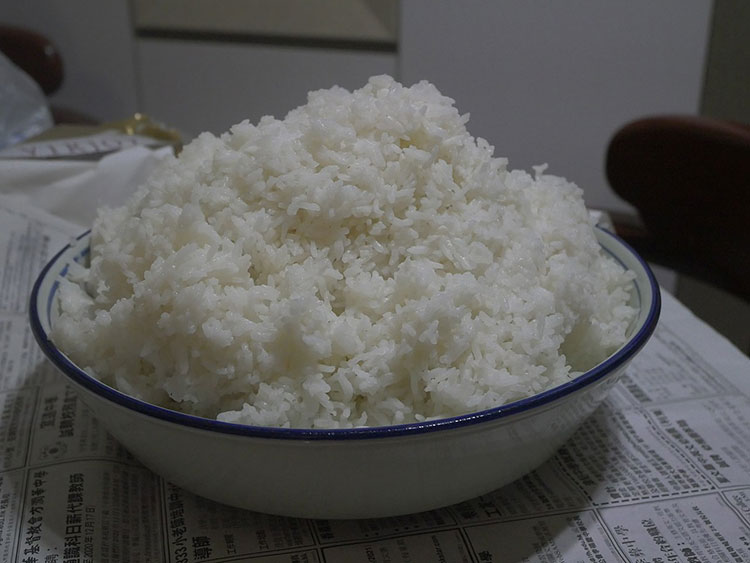
Rice Wrap Up
Storing rice long-term is the perfect entry point for new preppers to begin building up their emergency food supply. Too many people have the notion that prepping is expensive, and that to build up even a month’s worth of food is financially prohibitive.
If this is the case with your family or friends, use rice to show them an easier way. It’s hard to beat around seven days’ worth of food with just ten pounds for mere dollars. Yet rice can accomplish this, and as such it makes it a perfect “prepper” food. It’s a staple that should be stored with sugar, salt, beans, flour, and other foods.
What are your thoughts on the subject? Are there other tips or techniques you’d like to add to the conversation? Let us know in the comments below!



51 comments
couple of things to get good & better results >>>
you picture desiccant packs – but don’t actually mention them – don’t confuse them with 02 absorbers (common misconception for some reason ) – desiccants & absorbers must be separated as far from each other as possible – so desiccants always go on the bottom with the food pour following behind ….
there’s an “open air” time limit of approx 15 minutes on the 02 absorbers >>> you want ALL your food buckets prepped before opening the OEM factory master-pack – place your calculated number of absorbers on top and get the mylar bag heat sealing started – FAST!!!!
explore bucket lid options – you’re sealing food for 5 years plus (don’t bother with less) – 10/15/20/25/30 years – no need for an expensive $$$ lid – the $2 standard locking lid does the job nicely ….
Good suggestions!
How about food saver bags? They are not Mylar. You can freeze the rice, but for how long? Would it be wise to remove and place in the cans with the Gamma lids?
You can use food saver bags, but my guess is that Mylar bags will be less expensive in the longer run depending on how much you plan to store. You can buy big Mylar bags. You can freeze rice until it gets freezer burn, and food saver bags should help with that; but for prepping purposes, not relying on the freezer is ideal. Some people freeze rice just to make sure they kill off any little critters first but it’s just for that purpose and then they store it. Using oxygen absorbers should accomplish the same thing, however. I would not recommend Gamma lids for long-term “set it and forget it” storage in buckets only because they’re more expensive. I have Gamma lids but I use them on buckets that I am getting into often. They’re a whole lot easier for frequent access. Hope that helps.
Thank you!
It is best to freeze rice in the original package for a couple of days to kill off any of the creepy crawlers that have laid eggs inside then to prepare them for short or long term storage as almost all bagged rice and other dried products do have the possibility of bug infestion
clear and thorough information. thanks so much.
Hi ILLINI WARRIOR and Derrick, are desiccant packs necessary? and could you explain how to calculate amount of 02 absorbers to use? I read somewhere that you should spread out the absorbers throughout the bag for best results, is this true? Thanks, I’m just starting out.
They can’t hurt, but you should use O2 absorbers. You also want to spread them out, yes. Add one (or a few depending on the size) in the bottom, middle, and top.
Just an FYI. What you have pictured as an O2 absorber is actually silica gel moisture absorbers. If you actually meant moisture absorbers, you listed as O2. You can use both O2 and silica if you like. But they are both different with different functions. –Peace.
Can rice from the freezer be moved to Mylar bags for long term storage?
I’m not sure about that. I’d probably just opt to eat the rice from the freezer and buy new rice for Mylar bags.
Is there a way to dry out rice that has been frozen before putting in a Mylar bag
https://www.livestrong.com/article/471253-how-to-dry-rice/
Yes, but dry it. See other person’s comment and response.
My wife and started gardening last year and are now canning. We purchased a vacuum sealer and we ate curious how a vacuum system would work in this rice storage for long term. And do we need o2 packs if vacuuming?
It certainly can’t hurt to throw in an O2 pack if vacuum sealing, but you really don’t need to vacuum seal rice. I think the approach I outlined here is better unless you can use a vacuum sealer on large Mylar bags. You’re just going to get more stored rice with the large Mylar bags. Either scenario will work, however.
Yes, you’re right. I’ll fix it – thanks.
Thanks!
Your above Ad for Mylar bags is for 10 x 5 gallon bags with 10 x o2 absorbers. I have ordered this package but am worried now that because its only one absorber per bag, the bags won’t properly vacuum.
As you say, spread two or three out in the bag, I read a review that one alone doesn’t work.
Should I order more o2 absorbers on top of whats included?
Thanks.
Do you freeze your rice before storing? (to kill any bug that might be in the rice)
Yes, little effort for extra insurance.
If I use the food-grade buckets do I have to put the rice into Mylar bags? I’m not planning on years before I use the rice, but a good while anyway. Would the same process work for pinto beans?
You have to use Mylar bags to vacuum seal it. You don’t need to use them for general use/storage.
Just FYI, Some people think that O2 absorbers will create a vacuum effect and should visibly show the bag “sucked in”. This is not likely, depending on the amount of air volume when sealed. Oxygen is only about 20% of the volume of our air here on earth. The o2 absorbers will trap the oxygen but not the rest of the air. So about 4/5 of the air volume would be expected to remain in the space.
Right. Most of it will be nitrogen, which will not be absorbed. Thanks for chiming in.
After freezing your rice, how long do you let it set out to dry before storing it away in containers?
Until it’s fully dry. That time could vary.
I make instant rice by dehydrating cooked rice. In bad times fuel and water will be precious. This takes less water and fuel.
Does the dehydrated rice store long term in mylar bags too?
Yes
I have lots of white rice in 4# bags in the freezer that I would like to move to mason jars (to avoid taking up freezer space, and I have dozens of mason jars!). Can I just move them to sterilized mason jars? Do I need oxygen absorbers, and can I use a plastic mason lid or does it have to be rings & bands?
You can move them. Some people freeze their rice before storing long-term just to kill off any weevils before storing. Just make sure it’s dry. Yes, you can use mason jars. Store them in a cool dark place and ideally with O2 absorbers. As long as there is a decent seal with the lids you should be good.
Thanks again, Derrick! Would this method also work for cornmeal? I have a lot of it in the freezer as well.
I’m less familiar with cornmeal. This link suggests a freezer:
https://extension.missouri.edu/publications/gh1119
Thank you, that just seemed too easy!
I have a 25 lb bag of rice I bought in January 2020. It’s been in a bin in our garage ever since. The “expiration” date is May of 2022. Should I just buy a new bag (not that easy as we live out in the boonies), or would it be okay to freeze it for a little while and then process for storage as you have outlined with the mylar bags, absorbers and bucket? Thank you.
I would personally start with a fresh bag, but that’s just me. I’m guessing your garage is subject to a lot of temperature/humidity fluctuations, which aren’t great for food storage.
That’s what I was thinking as well. Thanks for the confirmation.
Just the information I was looking for. I also learned several things from the comments. I wasn’t sure how many O2 absorbers to use. I bought the 50 cc packets (didn’t know what I was doing), so I’m going to need to put in 40 if I fill up a 5 gal. bucket with flour (2000 cc) ? Did I read the chart correctly? Thank you for all the great info!
That’s correct. We learn through trial and error, right? I know I’ve screwed it up before.
How do you manage to dry all the rice by laying in a thin layer? Unless you have a large dedicate freezer and some way to stay trays, this would be very difficult. Would it be acceptable to dry the rice by placing in a bowl and leaving on the countertop for several hours?
Not as well. You need as much contact with the air as possible. An alternative (?) could be to clean all of your kitchen counters and spread it out there, dining room table, etc.
Thank you for the great info! I’m just getting started with prepping so have a lot to learn.
Could I vacuum seal the rice in mylar bags and THEN freeze it? Would moisture be a problem doing it that way? Or would vacuum sealing kill any bugs and eliminate the need for freezing?
Freeze before Mylar if your objective is to kill bugs, but any bugs should be killed when starved of oxygen in Mylar. Welcome to prepping!
Why are the mylar bags that you are recommending so much more expensive than others?
Am I correct in understand that you are saying that the food grade 5 gallon buckets are not going to safely store your rice even if it has oxygen absorbers? I believe I’m hearing you say that you need to use mylar bags to truly keep your rice free from oxygen. Is that the case?
Those are five-gallon Mylar bags with O2 absorbers, that’s why they’re more expensive. You can use a five-gallon bucket to store rice with O2 absorbers so long as you’re certain it has an airtight seal. That’s just not the approach most people use because with the Mylar bags you know for sure it’s sealed because you can see that it’s sealed.
What if you do find several worms in your bucket of rice? If you remove them, is the rice still safe to eat?
Still safe to eat, and in a survival situation you can think of the worms as extra fat calories!
I have Mylar bags and heat sealer, when storing the rice u get from the store I am planning on but a few extra pound when I shop. Can I keep them in the plastic bag they come in before putting in the mylar bag and then placing the oxygen absorbent and then seal, or do I have to take rice out of bag if I take it out of bag can I put in a freezer bag before sealing?
I don’t think any of that will matter.